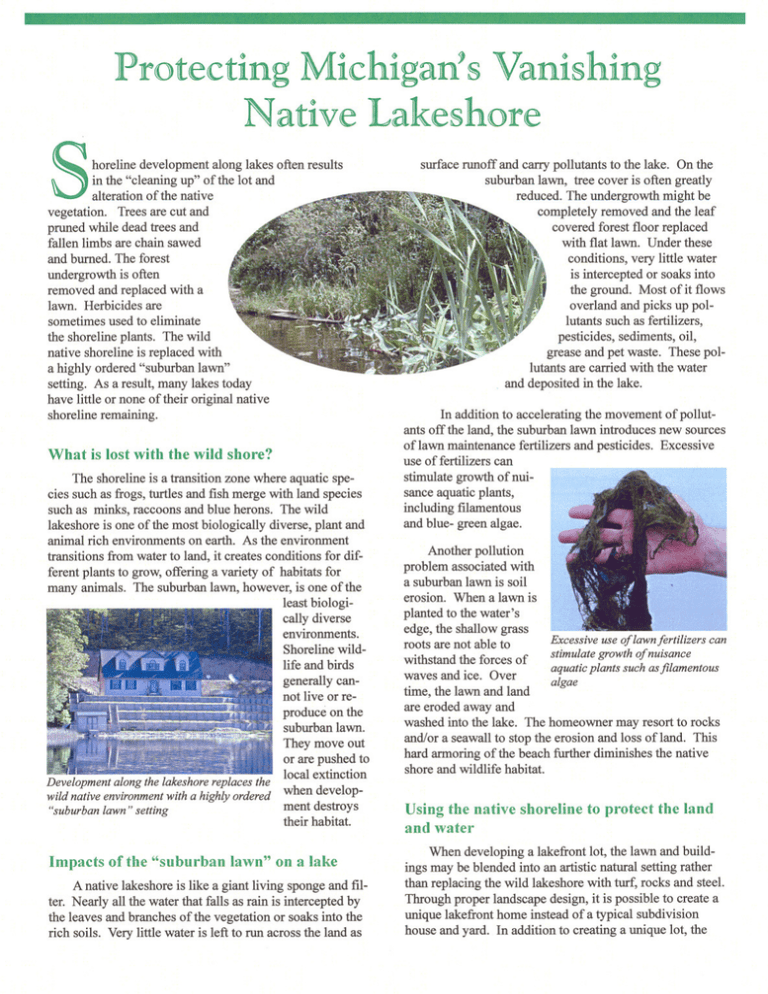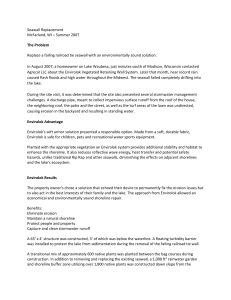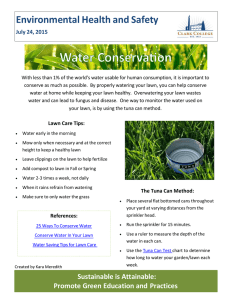Protecting Michigan s Vanishing Native Lakeshore
advertisement

Protecting Michigan s Vanishing Native Lakeshore in the "cleaning up" of the lot and Shoreline alteration development of the native along lakes often results vegetation. Trees are cut and pruned while dead trees and fallen limbs are chain sawed and burned. The forest undergrowth is often removed and replaced with a lawn. Herbicides are sometimes used to eliminate conditions, very little water is intercepted or soaks into the ground. Most of it flows overland and picks up pollutants such as fertilizers, pesticides, sediments, oil, grease and pet waste. These pollutants are carried with the water . and deposited in the lake. the shoreline plants. The wild native shoreline is replaced with a highly ordered "suburban lawn" setting. As a result, many lakes today have little or none of their original native shoreline remaining. In addition to accelerating the movement ofpollutants off the land, the suburban lawn introduces new sources of lawn maintenance fertilizers and pesticides. Excessive use of fertilizers can What is lost with the wild shore? The shoreline is a transition zone where aquatic species such as frogs, turtles and fish merge with land species such as minks, raccoons and blue herons. The wild lakeshore is one of the most biologically diverse, plant and animal rich environments on earth. As the environment transitions from water to land, it creates conditions for different plants to grow, offering a variety of habitats for many animals. The suburban lawn, however, is one of the least biologically diverse environments. Shoreline wildlife and birds generally cannot live or re- Development along the lakeshore replaces the wild native environment with a highly ordered "suburban lawn" setting surface runoff and carry pollutants to the lake. On the suburban lawn, tree cover is often greatly reduced. The undergrowth might be completely removed and the leaf covered forest floor replaced with flat lawn. Under these produce on the suburban lawn. They move out or are pushed to local extinction when development destroys their habitat. Impacts of the "suburban lawn" on a lake A native lakeshore is like a giant living sponge and filter. Nearly all the water that falls as rain is intercepted by the leaves and branches of the vegetation or soaks into the rich soils. Very little water is left to run across the land as stimulate growth ofnuisance aquatic plants, including filamentous and blue- green algae. Another pollution problem associated with a suburban lawn is soil erosion. When a lawn is planted to the water's edge, the shallow grass Excessive use of lawn fertilizers can roots are not able to stimulate growth of nuisance withstand the forces of aquatic plants such as filamentous waves and ice. Over algae time, the lawn and land are eroded away and washed into the lake. The homeowner may resort to rocks and/or a seawall to stop the erosion and loss ofland. This hard armoring of the beach further diminishes the native shore and wildlife habitat. Using the native shoreline to protect the land and water When developing a lakefront lot, the lawn and buildings may be blended into an artistic natural setting rather than replacing the wild lakeshore with turf, rocks and steel. Through proper landscape design, it is possible to create a unique lakefront home instead of a typical subdivision house and yard. In addition to creating a unique lot, the natural shoreline will minimize pollution, protect the shoreline from erosion and • The buffer zone should extend 25 to 50 feet out into the water and up onto the land. It should occupy 60 to 80 percent of the lot's lake frontage • The buffer zone can be divided into three planting areas: 1) aquatic plants which grow below the water surface; 2) moist-soil plants, such as cattail, bulrush, arrowhead and pickerelweed, growing in the wave-washed area; and 3) dry-soil plants, such as native grasses, wild flowers, shrubs and trees growing up slope from the waters edge • Plants used in the buffer zone should be native plants that historically grew along the lakeshore in the local area. Native plants will be easier to establish, grow more luxuriously and require less maintenance. They also provide the structure, habitat and seed crop that local animals utilize in feeding, nesting and resting • The lawn should be kept back from the lake's edge but may meander among the plantings as a pathway from the yard to the swimming and boating area provide a home for the wildlife that live at the water's edge. When con.. t· Use. of the WIld natIve shore can create a Stru cmga ... umque lakefront home dlstmctlve waterfront home consider the following: • Remove only those trees necessary to build and protect the house and open a view to the lake • Keep the lawn away from the lake. Use plants that need little watering or fertilization • Maintain brush cover on steep sloping lands • Allow a buffer zone of native vegetation along the lakeshore • Keep boating and swimming areas as small as possible to maintain the native shoreline • Avoid retaining walls; instead use long-rooted native plants and shrubs or rock rip-rap to control erosion. Always line rock with geotextile fabric. Restoring the native shoreline If a lakefront home already has a suburban lawn to the edge of the lake, the wildlife habitat will be minimal and an erosion problemmayalready be present. The native shoreline can be reestablished by planting a lakeshore buffer zone. This zone might consist of low When a lawn is planted to the water :sedge, the lawn and land are slowly eroded away and washed into the lake growing shrubs and flowers, with taller trees along the lot sides. This combination of plantings maintains the view of the lake and screens other lot development from view. Creative use of the lawn and native plants in artistically designed assemblages can prevent erosion, restore wild native habitat and associated wildlife and protect the lake from surface runoff. More information about native lakeshore management is available in Islands of low growing shrubs andflowers can the book maintain the lake view Lakescaping for Wildlife and Water Quality, written by C. Henderson, C. Dindorf and F. Rozumalski and published by the Nongame Wildlife Program, Minnesota Department of Natural Resources. It is available through the MSU Extension Bulletin Office, Agriculture Hall, Michigan State University, East Lansing, MI 48824; 517-353-6740 or order online at: web2.msue.msu.edulbulletins/mainsearch.cfrn. Request inventory number WQ 57. Written by Howard Wandell, Department of Fisheries and Wildlife, Lois Wolfson, Institute of Water Research and Jane Herbert, Kellogg Biological Station, Michigan State University; Photographs by Bill Bartodzieji and Howard Wandell. Financial support was provided by the Water Quality Area of Expertise Team. 'i'" < , ~. < ,.f ~~ ..•~".<O;""•• When constructing the buffer zone and designing the plantings, the following guidelines should be considered: '~;'ilo;<.~".,: • ..:<.)1'" MSU is an affirmative action-equal opportunity institution



